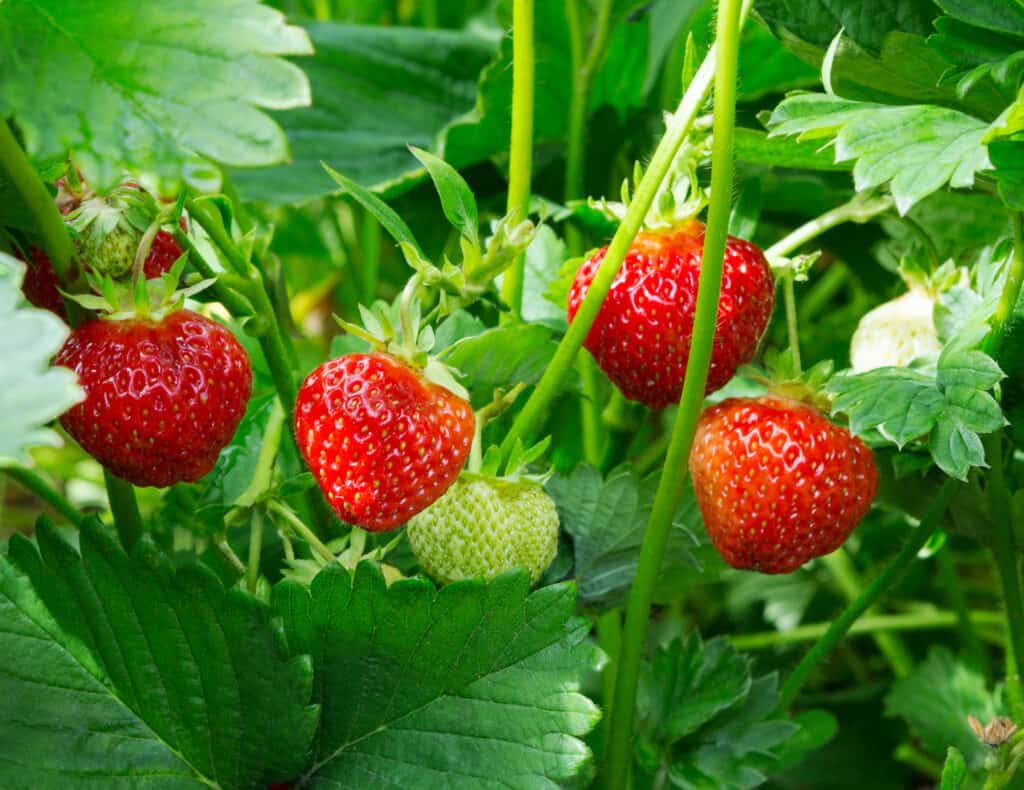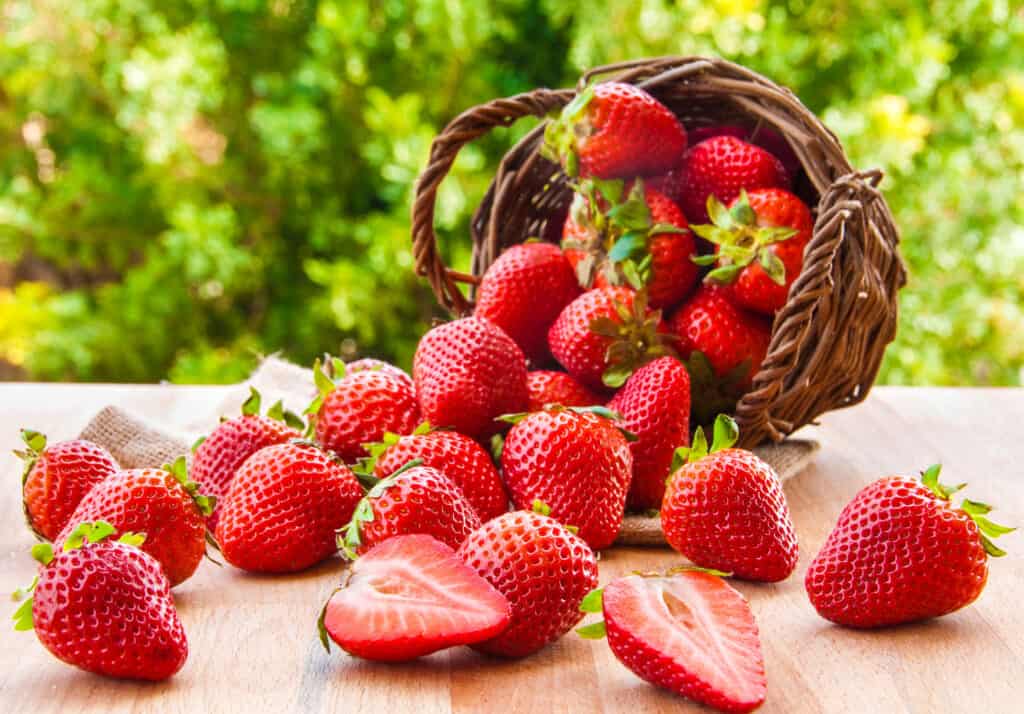Welcome to our blog post on growing strawberries in Ohio! In this article, we will explore the ideal timing for cultivating these juicy delights in the Buckeye State. Whether you are a seasoned gardener or a beginner, we’ve got you covered with helpful tips and tricks to maximize your strawberry harvest. Let’s dive right in!
Ohio Gardening Climate
Ohio is home to two USDA Hardiness Zones, Zone 5 and Zone 6. The majority of the state lies in Zone 6, but there are also small patches of Zone 5. Gardeners should expect a moderate climate in Ohio, with cold winters and hot, humid summers. The climate is well-suited for many plants that thrive in a temperate environment, including trees, shrubs, and perennials. Strawberries thrive throughout the state of Ohio.
Ohio’s Zone 5 is generally cooler than Zone 6, and temperatures can drop below -15°F during the winter. While the cold can be concerning for some gardeners, many hearty plants can still survive in this zone. Gardeners should consider planting cold-tolerant varieties, such as evergreens, that can withstand the cold weather. Zone 6 tends to be slightly warmer than Zone 5, and temperatures rarely drop below -5°F.
Ohio Spring Frost Dates
In most of Ohio, the last frost of the season usually happens between May 1st to 15th. However, northern Ohio and a portion of southern Ohio have the last frosts that occur from April 16th to 30th.
| City in Ohio | Last Spring Frost Date |
|---|---|
| Akron, Ohio | April 30th |
| Ashland, Ohio | May 7th |
| Boardman, Ohio | May 9th |
| Bowling Green, Ohio | April 29th |
| Brunswick, Ohio | April 27th |
| Cleveland, Ohio | April 23rd |
| Columbus, Ohio | April 27th |
| Dayton, Ohio | April 25th |
| Kent, Ohio | April 27th |
| Mason, Ohio | April 30th |
| Sandusky, Ohio | April 16th |
| Springfield, Ohio | May 2nd |
| Wooster, Ohio | May 8th |
When to Plant Strawberries in Ohio

You can plant your strawberries in April in Ohio.
©iStock.com/romiri
In most of Ohio, the best time to plant strawberries is in April. To ensure successful root and fruit growth, temperatures should remain above 60°F. Refer to the above frost-date chart to pick the perfect time to plant strawberries.
Strawberry plants are pretty tolerant of frost, but frost can damage strawberry blossoms. If you want to plant your strawberries early, feel free. Just be sure to provide frost protection in the form of plastic covers or cloth covers when a frost pops up.
How Many Strawberries to Plant
If you’re looking to grow strawberries in Ohio, then you need to be aware of the best timing for planting and have a few helpful tips on hand. Strawberries are an ideal choice for a home garden due to the fact that they give a high yield in a small amount of space. June-bearing cultivars generally have their first harvest in the second year, while everbearing and day-neutral cultivars can give you fruit in the first year. On average, each plant will produce up to one quart of strawberries.
For a family of four, 25 strawberry plants should be enough to provide a good yield. Extra plants are usually available at a low cost, so it’s easy to stock up if you want more. If you’re left with extra berries, they can be made into jams or frozen for later use.
To ensure a good harvest of strawberries each season, it’s important to establish a new planting after the plants have yielded fruit for three or four years. After three years of growing the fruit, the bed should also be renovated to extend its productivity for an additional one or two years.
Types of Strawberries

There are three main types of strawberry plants to choose from.
©nadia_if/Shutterstock.com
Strawberry plants can be broadly divided into three main types: June-bearing, everbearing, and day-neutral.
June-bearing strawberries are the classic, widely-recognized type of strawberry. They produce their berries during a period of around three weeks in the middle of the summer, usually in June. June-bearing varieties are typically large and sweet, and they are the type of strawberry found most commonly in grocery stores.
Everbearing strawberries produce two main crops of fruit, one in the late spring and another in the early fall. They are smaller and less sweet than June-bearing varieties, but they are a great choice for gardeners looking to extend their harvest season.
Day-neutral strawberries are the most hardy of the three types, and they can produce berries from spring to fall. They are smaller and more tart than June-bearing and everbearing varieties, but they are extremely productive and are popular among commercial growers.
Overall, regardless of the type of strawberry you choose, they are all easy to grow and can provide a delicious and nutritious addition to your garden.
Strawberry Cultivars That Thrive in Ohio
- Albion — A large, sweet berry with good disease resistance and good production, making it an ideal choice for Ohio’s climate.
- Jewel — An early-maturing berry with large, sweet fruit that is highly resistant to many diseases.
- Totem — A medium-sized berry with superior cold tolerance, making it well-suited for Ohio’s seasonal fluctuations.
- Seascape — A late-season berry with good disease resistance and sweet, juicy fruit, ideal for Ohio’s short growing season.
- Eversweet — A low-maintenance berry with excellent disease resistance and a firm texture, making it an excellent choice for Ohio’s humid climate.
Where To Plant Strawberries

You don’t have to have a garden to grow strawberries. They do very well in pots or baskets.
©AVN Photo Lab/Shutterstock.com
For the best quality and highest yield of strawberries, plant your strawberries in full sun and in soil that is loose and rich with organic matter. The pH of the soil should be between 5.8 and 6.5. Have your county Extension office test the soil for acidity and fertility, as well as for organic matter and boron. Depending on the test results, lime, and fertilizers should be applied accordingly.
Gardeners should be mindful of where they plant their strawberry plants in Ohio. They should avoid areas where there is an issue with drainage and where potatoes, tomatoes, or grass were recently grown. If this is done, it can help to reduce the risk of insect or disease damage to the plants.
When and How to Plant Strawberries in Ohio

Plant strawberries with the crown only partially buried so it does not rot.
©goja1/Shutterstock.com
In Ohio, the best time to plant strawberry plants is during the early spring months as long as the ground is not excessively wet. Planting in the fall is not recommended since the soil can experience heaving (when it goes from freezing to thawing). When planting, make sure to bury the roots and only half of the crown stem. Dig a trench deep enough so that the roots can be planted vertically, not horizontally.
Plant your June-bearing strawberries 12 to 24 inches apart. During the first season, any extra runners should be removed to control the spread of the plants. In August, rows should be 18 to 24 inches wide, with plants 6 to 8 inches apart. Rows should be 36 to 40 inches apart. If there is limited space, a circular terrace can be used to plant the strawberries.
To grow day-neutral strawberries in Ohio, space them 8-12 inches apart with 30-36 inches between each row. Remove runners and flowers for the first 6 weeks after planting, and cover the area with 3-4 inches of straw or other mulch to maintain moisture.
How to Care for Strawberry Plants
During dry periods, it is important to give your strawberry plants extra water. Strawberries need around 1 to 1.5 inches per week. Be especially mindful of water needs between mid-June and mid-August.
To avoid problems with pests or diseases, try to choose a spot that has not recently had potatoes, tomatoes, or sod grown. Mulching with straw that is free from weed seeds can help protect the plants during winter and should be applied 2 to 3 inches deep after the plants have been exposed to freezing temperatures. Apply thick winter protection of mulch in November or December (no later than December 15).
When and How to Harvest Strawberries

You can grow strawberries in Ohio easily with these helpful tips.
©iStock.com/MariaUspenskaya
In Ohio, the harvesting season for June-bearing strawberry cultivars typically begins at the end of May and continues until the end of June. Everbearing cultivars are able to produce one crop in the year they are planted, with two smaller harvests in late spring and early fall. Furthermore, day-neutral plants can yield fruit for most of the gardening season.
Harvesting strawberries is easy! Start by gently twisting the ripe berries off the plant. Put the ripe strawberries in a basket or container. Make sure not to pick any unripe berries. If the berry doesn’t come off easily, leave it on the plant. Enjoy your freshly harvested strawberries!
How to Use and Preserve Strawberries
A gardener can enjoy strawberries in many ways! Freshly picked strawberries are delicious, just eaten as-is or added to a variety of dishes. You can freeze strawberries to extend their shelf-life, and they are great for smoothies or baking. Jam and jelly are popular ways to use up excess strawberries, and you can enjoy them all year round. Strawberries can also be dried, either in the sun or in a dehydrator. Dried strawberries are a great snack, or you can use them in baking and muesli. Lastly, you can preserve strawberries in alcohol, like vodka or liqueurs, and then use them to flavor cocktails and desserts. With so many tasty options, there’s never a shortage of ways to enjoy and preserve strawberries!
Helpful Tips for Ohio Gardeners Who Want to Grow Strawberries

Russian tortoises love strawberries. Be sure to plant a row for them too!
©Elena M. Tarasova/Shutterstock.com
- Choose a sunny, well-drained spot for your strawberry patch.
- Plant strawberries in the early spring, usually in April.
- Make sure your soil is rich in organic matter.
- Use mulch to help keep the soil moist and reduce weeds.
- Water your strawberry patch regularly. 1 inch of water per week minimum.
- Inspect your strawberry plants regularly for pests and diseases.
- Fertilize your strawberry plants with a balanced fertilizer.
- Harvest strawberries as soon as they are ripe.
- Don’t forget to prune your strawberry plants in the spring.
- Plant 25 plants for every four people in the household.
The photo featured at the top of this post is © iStock.com/Ирина Мещерякова
Thank you for reading! Have some feedback for us? Contact the AZ Animals editorial team.







